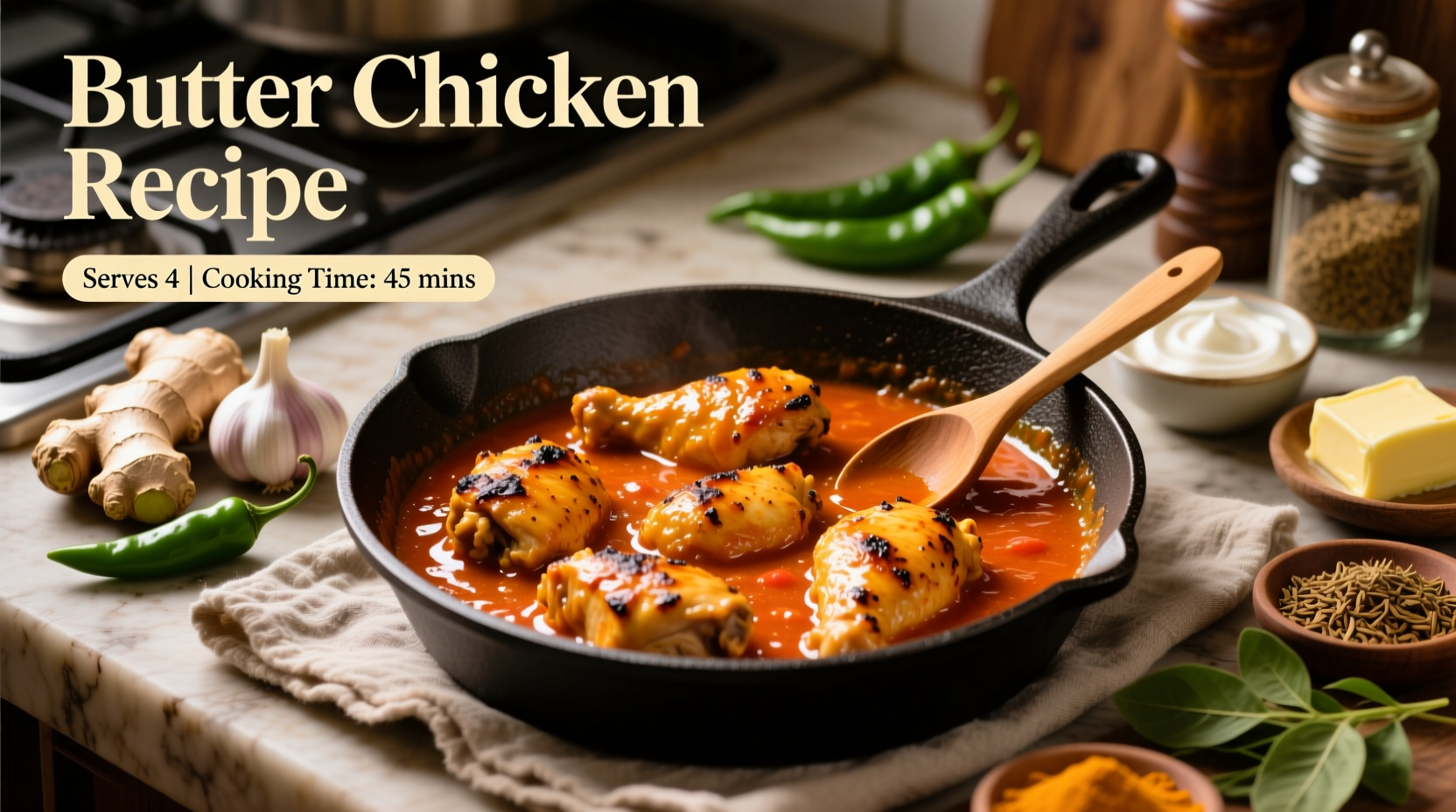The Essential Butter Chicken Recipe You've Been Searching For
Nothing beats the creamy, aromatic perfection of homemade butter chicken when you nail the balance of spices and technique. Unlike restaurant versions that often rely on pre-made sauces, this authentic approach builds flavor layer by layer—starting with properly marinated chicken that stays tender through cooking. The magic happens when you toast whole spices, bloom them in butter, and finish with that signature fenugreek aroma. Let's transform your weeknight dinner with restaurant-quality results.
Understanding Butter Chicken's Culinary Journey
Originating in 1950s Delhi at Moti Mahal restaurant, butter chicken (murgh makhani) was born from culinary innovation. Chefs repurposed leftover tandoori chicken by simmering it in a spiced tomato gravy, creating what's now India's most exported dish. While modern versions vary globally, authentic preparation maintains specific techniques that distinguish it from generic "chicken curry."
| Traditional Preparation | Common Western Adaptations | Impact on Flavor |
|---|---|---|
| Kashmiri red chilies (mild heat) | Cayenne pepper | Authentic version has vibrant color without intense burn |
| Freshly ground garam masala | Premixed spice blends | Custom blends provide brighter, more complex notes |
| Slow reduction of tomato gravy | Cream added early | Proper reduction creates richer, non-cloying sauce |
| Kasuri methi (dried fenugreek) | Fenugreek powder | Freshly crushed leaves deliver superior aromatic finish |
Why Your Butter Chicken Recipe Failed (And How to Fix It)
Most home cooks make three critical errors: using low-fat yogurt that curdles, skipping the kasuri methi, and adding cream too early. Food science explains why these matter—full-fat dairy proteins protect against curdling at high heat, while fenugreek's volatile oils dissipate if cooked too long. The cream must wait until the tomato base has reduced sufficiently, otherwise you'll get a separated, watery sauce.

Your Butter Chicken Success Toolkit
Non-Negotiable Ingredients
- Chicken thighs: Their fat content prevents drying during cooking (breasts often become tough)
- Full-fat yogurt: Minimum 5% fat content for stable marination
- Kashmiri chili powder: Provides color without overwhelming heat (substitute: 1 part cayenne + 3 parts paprika)
- Fresh ginger-garlic paste: Never use pre-minced versions for authentic flavor
- Kasuri methi: Dried fenugreek leaves crushed between palms just before serving
Equipment Checklist
- Cast iron or carbon steel skillet (for even browning)
- Wooden skewers (if grilling)
- Mortar and pestle (for optimal spice grinding)
- Heavy-bottomed pot (for sauce reduction)
The Step-by-Step Cooking Process
Phase 1: Marinating (2-3 hours)
- Cut 1.5 lbs chicken thighs into 1.5-inch pieces
- Mix with ½ cup full-fat yogurt, 1 tbsp ginger-garlic paste, 1 tsp Kashmiri chili, ½ tsp turmeric
- Add 1 tbsp lemon juice and 1 tsp garam masala
- Cover and refrigerate minimum 2 hours (overnight for best results)
Phase 2: Cooking the Chicken (15 minutes)
- Preheat oven to 400°F (200°C) or prepare grill
- Remove chicken from marinade, shaking off excess
- Cook 8-10 minutes until edges char but center remains slightly pink
- Set aside—do not fully cook at this stage
Phase 3: Building the Sauce (20 minutes)
- Melt 3 tbsp butter with 1 tbsp oil in heavy pot
- Add 1 tsp cumin seeds until they sizzle
- Stir in 1 chopped onion until golden (8-10 minutes)
- Add 1 tbsp ginger-garlic paste, cook 2 minutes
- Mix in 2 tbsp tomato paste, cook until oil separates
- Add 1 cup crushed tomatoes, simmer 10 minutes
- Stir in 1 tsp garam masala, ½ tsp Kashmiri chili, salt to taste
Phase 4: Final Assembly (10 minutes)
- Add cooked chicken to sauce, simmer 5 minutes
- Stir in ½ cup heavy cream and 1 tbsp honey
- Crush 1 tbsp kasuri methi between palms, sprinkle over top
- Garnish with cilantro and 1 tbsp butter
- Rest 5 minutes before serving
Critical Timing Considerations
Butter chicken's evolution shows why timing matters:
- 1950s: Original Moti Mahal version used leftover tandoori chicken, requiring no additional cooking
- 1970s: Home cooks began marinating specifically for butter chicken, establishing 2-hour minimum
- 1990s: Cream addition timing became standardized to prevent curdling
- Today: Modern food science confirms 30 minutes total simmering creates optimal texture
When Substitutions Work (And When They Don't)
Understanding context boundaries prevents recipe failures:
- Yogurt substitute: Only full-fat coconut milk works (low-fat alternatives will curdle)
- Chicken alternative: Paneer works for vegetarian version but requires 50% less cooking time
- Cream substitute: Cashew cream acceptable, but never use milk (will split)
- Spice warning: Skip kasuri methi only if unavailable—never substitute with fenugreek seeds
Serving Like a Pro
The perfect butter chicken has a specific texture profile: sauce should coat the back of a spoon but remain pourable. Serve immediately with:
- Steamed basmati rice (rinse 3 times for optimal fluffiness)
- Freshly made naan (bubbled surface traps sauce)
- Sliced red onions with lemon wedges (cuts through richness)
Avoid common presentation mistakes: never serve piping hot (let rest 5 minutes), don't drown in sauce (2:1 sauce-to-chicken ratio), and always finish with that final butter pat for sheen.
Storage and Reheating Science
Butter chicken improves overnight as flavors meld, but proper storage is critical:
- Cool completely before refrigerating (prevents condensation)
- Store in airtight container for up to 3 days
- Reheat gently on stove with 1 tbsp water (microwaving causes separation)
- Freeze without cream for best results (add fresh cream when reheating)











 浙公网安备
33010002000092号
浙公网安备
33010002000092号 浙B2-20120091-4
浙B2-20120091-4